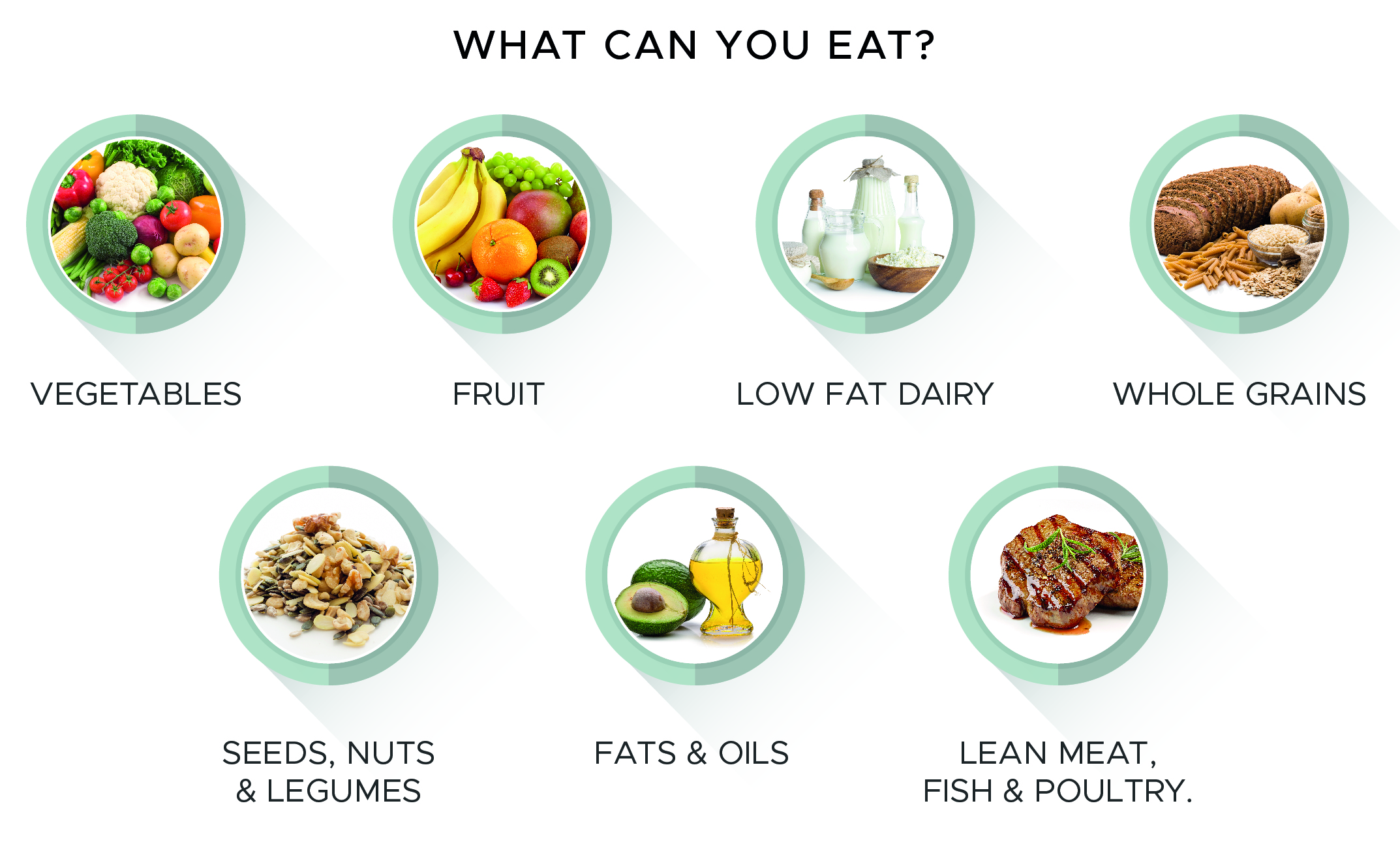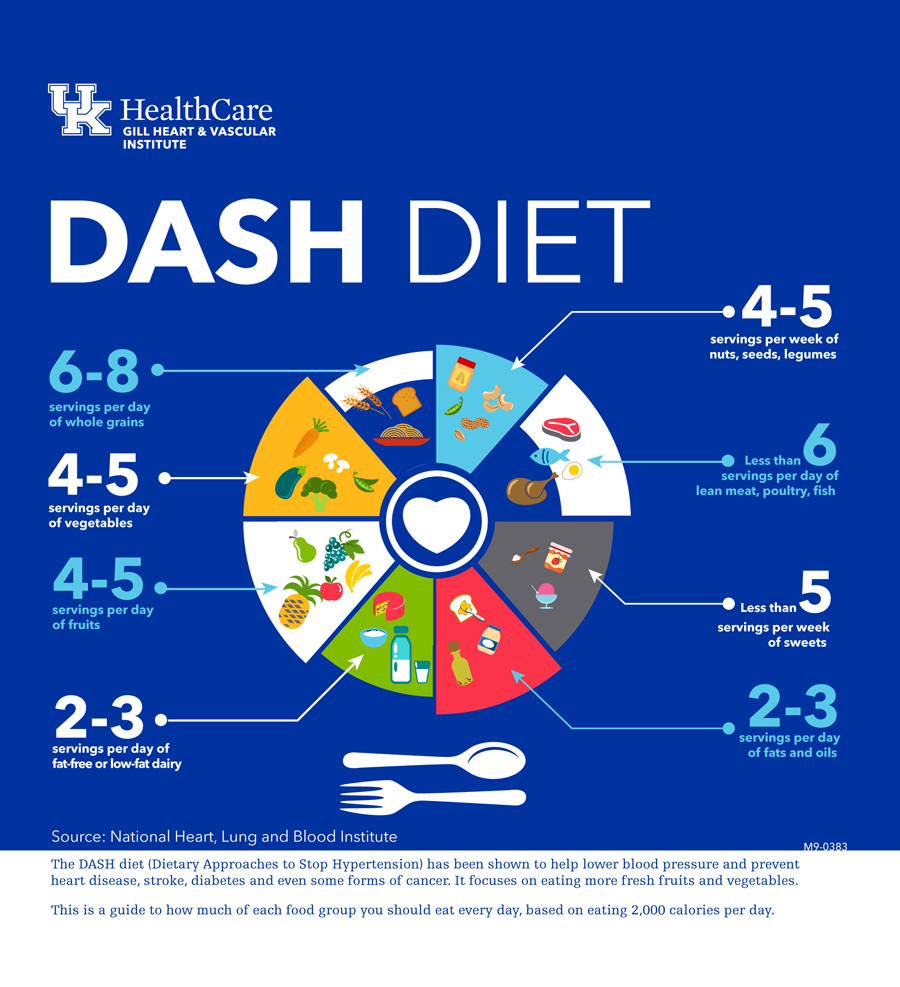What is the DASH Diet?
Dietary Approaches to Stop Hypertension, or DASH, is a diet plan recommended for those who want to prevent or stop high blood pressure. It does this by increasing the intake of fiber and heart-healthy minerals, including calcium, potassium and magnesium, while decreasing the amount of sodium and unhealthy fats that you eat.

The DASH diet emphasizes fruits, vegetables, whole grains, lean protein and low-fat dairy. This eating pattern limits foods with added sugar and those high in saturated fat – such as fatty meats, full-fat dairy foods and tropical oils. Most importantly, the DASH diet caps sodium at 2,300 milligrams daily, which followers will often lower to about 1,500 milligrams.
How Does the DASH Diet Work?
The DASH diet is similar to the Mediterranean dietary pattern but gives more concrete recommendations on actual amounts and limits of types of foods consumed.
You’ll fill up on vegetables, fruits and whole grains on the DASH diet. You can also enjoy moderate amounts of fat-free or low-fat dairy products, fish, poultry, beans and nuts. Foods high in saturated fat, such as fatty meats and full-fat dairy products, are strictly limited or, better yet, avoided altogether.

“This style of eating isn’t telling you that you have to eliminate food groups, but instead gives you guidelines on how many servings per week you should ideally consume,” explains Lindsey Pine, a registered dietitian nutritionist in Los Angeles. “(It’s) more than just an eating pattern to reduce blood pressure and offers so many additional whole-body health benefits, similar to the Mediterranean diet.”
Can I Lose Weight on the DASH Diet?
Yes, you can lose weight in a safe and sustainable way on the DASH Diet. However, the trick is to keep an eye on your portion sizes and consider the calorie content of the foods you choose.
“DASH isn’t a weight loss diet per se, but you certainly can lose weight if you create a calorie deficit,” says Rosanne Rust, a registered dietitian and co-author of several DASH diet cookbooks, including the “DASH Diet For Dummies.” “Often when people transition from their normal food choices to a DASH eating style, they may automatically reduce calories since they’re adding more vegetables and balanced meals to their diet.”

For reference, women usually consume 1,200 to 1,600 calories on the DASH diet, while men consume 1,600 to 2,000. Some people have an easier time losing weight if they eat small, frequent meals throughout the day, while others do better with a few larger meals. You should try both methods to see what works best for you.
If weight loss is your goal, complement your healthy eating plan with regular exercise and review our Best Weight Loss Diets list for more inspiration.
Short-Term Weight Loss
Although the DASH diet is not specifically designed for weight loss, it can help people lose weight.
- A meta-analysis of clinical trials showed that DASH dieters lost an additional 3.1 pounds over the course of eight to 24 weeks, 0.4 units of body mass index in eight to 52 weeks and 1.05 centimeters of waist circumference in 24 weeks compared to those on the control diets.
- In a randomized clinical trial, the DASH diet was associated with significantly decreased weight and BMI after eight weeks compared to the control diet.
Long-Term Weight Loss
If you remove processed, sugary, salty and high-fat foods from your diet, as you do on the DASH diet, and exercise regularly, you’ll likely continue to lose weight.
Weight Maintenance and Management
Once you’ve reached your target weight, you should be able to maintain it on the DASH diet. The fiber and protein will keep you satiated, while the calorie content is adequate to keep you energized.
How to Get Started on the DASH Diet
Instead of making drastic changes to your diet, you can start on the DASH diet by making small changes to your eating habits.
For example:

- Add one serving of vegetables or fruit to every meal.
- Introduce two or more meat-free meals each week.
- Use herbs and spices to make food tastier without salt.
- Snack on almonds, pecans or other nuts instead of potato chips.
- Switch from white flour to whole-wheat flour when possible.
- Take a 15-minute walk after lunch or dinner (or both).
- Plan a few weeks of meals and shopping lists to get you started.
- Look at the menus at the restaurants you dine at most often and decide what you will order.
What Does the DASH Diet Cost?
The only cost of following a DASH diet is the expense of food, so with planning your costs can be similar to your typical grocery trip, as healthy whole foods don’t have to be exotic or pricey. The hit to your wallet will depend on what foods you choose to purchase. For example, Mexican American-Hispanic individuals didn’t spend more on food when adopting the DASH diet because their traditional diet is nutrient dense and relatively cheap, according to one study.
Is DASH Diet Easy to Follow?
The DASH diet is ranked No. 3 (tied) in Easiest Diets to Follow.
- Family friendly. Family members can easily eat the meals together with little or no modification. The food options are healthy and balanced enough for all ages.
- Budget friendly. Foods for this diet are easy to find at a typical grocery and don’t require expensive or specialty items.
- Planet friendly. The diet considers the environmental effects of food choices. It’s predominantly plant-based, or the foods are mainly sustainably grown/produced.
- Vegan or vegetarian friendly. Individuals can easily modify recipes for a vegan or vegetarian diet.
- Gluten-free friendly. Recipes can be easily modified to follow a gluten-free diet.
- Halal friendly. Recipes can be easily modified to follow a halal diet.
- Kosher friendly. Recipes can be easily modified to follow a kosher diet.
- Low-fat. The diet encourages a moderate consumption of healthy fats – like polyunsaturated fats found in olive oil – and discourages unhealthy, saturated fats. Less than about 30% of total calories come from fat.

While it may be challenging to give up your favorite fatty, sugary and salty fare, DASH doesn’t restrict entire food groups, so you can stick with it long term.
Following DASH is relatively convenient. The NHLBI offers more than 180 heart-healthy recipes in its online database. Otherwise, many reputable organizations, such as the Mayo Clinic, provide long lists of DASH-friendly recipes.
Those who wish to have a little more flexibility can substitute some protein or unsaturated fat for a portion of daily carbs and still reap the heart health benefits from DASH, according to research.
“DASH is adaptable to just about every culture’s food, even if dairy is not part of your eating plan,” Rust says, adding that the nondairy DASH diet still lowered blood pressure in clinical trials, although the pattern with dairy reduced it more.
Who Should Not Try the DASH Diet?
The DASH diet is a healthy choice for most adults unless your doctor recommends you restrict a specific nutrient. Those with kidney disease may need a low-potassium diet, for example. If you have any concerns, speak to your doctor before trying the DASH diet.